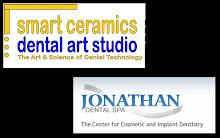
Are silver fillings really bad for you?
There has been much talk about the hazard of Amalgam (silver fillings). My practice does not utilize amalgam fillings. The reason is not because they are hazardous, or they are inferior materials, but because my patients just do not want silver fillings in their mouths for esthetic reasons. Here is an article written by Dr. Gordon Christensen, one of the guru's in dentistry. It is listed on my website (www.implants-for-u.com) or you may read it below. Inquiries are welcome.
Happy reading
Dr. Jonathan.
The Use of Mercury Containing Restorations (Fillings) in Dentistry
Gordon J. Christensen, DDS, MSD, Ph.D.
"Dental amalgam containing roughly 50% mercury has been used in dentistry for well over 100 years. Almost all health organizations around the world support the continued use of silver amalgam. However, there is continuing controversy about the desirability of having mercury containing restorations in the mouth, because of the minute amounts of mercury that are released from these restorations. It is highly unlikely that such small concentrations of mercury can or do harm the typical human. However, there is a remote chance that persons who have immunocompromised systems could have some negative influence from this mercury presence or the presence of other metals.
Around the world, silver amalgam is in various states of challenge. In Germany, silver amalgam has been eliminated from use. In Sweden, it is planned that silver amalgam use will be discontinued next year. In numerous other countries, silver amalgam is being taught to a less degree than in the past in the dental schools because of alleged contamination of sewer lines and other biologic hazards. Nevertheless, almost every health organization throughout the world supports the continued use of silver amalgam. Many people do not want silver amalgam in their mouths because of its unesthetic appearance, and we are finding that the change from silver fillings to white fillings has been related more to persons desiring esthetic dentitions than it has been to alleged biologic hazards.
There are many elements used in the mouth that are potentially allergenic. Among them is mercury. However, far more potentially allergenic is the element nickel, which is used in many dental restorations. Additionally, there are many other elements used in the mouth that could cause allergic reactions in people, manifested by red gums, a burning taste in the mouth, and signs that are evident only to dentists.
The other potentially negative aspect of silver amalgam is the toxicity question. This is still unanswered, and it is likely that it will remain unanswered because of the confusion that is currently present in the scientific area concerning the alleged toxicity of silver amalgam.
There are many new materials that are available for restoration of teeth excluding silver amalgam. Among them are composite resin white fillings that are used for small restorations in teeth, and new polyglass crowns that are available to replace the typical porcelain-fused-to-metal crowns that have been the mainstay for teeth that are very broken down. It is likely that continued research will produce materials that will eventually eliminate the use of metal in the human mouth.
In summary, silver amalgam continues to be used as the major restorative material in dentistry throughout the world. Its alleged allergenicity and toxicity are argued in the most scientific of organizations, but conclusive evidence concerning the need to eliminate this restorative material from common usage is still highly controversial. If patients desire to have tooth colored restorations, they are available today, and most of these have little or no known toxicity or allergenicity. Patients who desire to have elimination of silver amalgam from their mouths for esthetic reasons should contact their dentist to see if this is available from the practices in which they are involved. Patients who desire to have silver amalgams removed because of alleged toxicity or allergenicity challenges will find it very difficult to have these potentials evaluated, and it is likely that results will be inconclusive.
Dentistry is pleased to have the presence of many new materials that will eventually replace silver amalgam.
The above article is copyrighted by Dr. Gordon Christensen of Clinical Research Associates


2 Comments:
If this information is so "secret", are you sure you want to give it away?
The only reason it is secret is because some dentists don't want to tell you this information, because it may hurt their pocket or they are too lazy to do it. I will share this info with my patients and all alike so that they can be informed when they receive treatment at the dental office.
Dr Jonathan
Post a Comment
Subscribe to Post Comments [Atom]
<< Home